A New Analytical Wake Model for Yawed Wind Turbines
Abstract
:1. Introduction
2. Numerical Model
2.1. Governing Equations
2.2. The Turbulence Model
2.3. Wind Turbine Model
2.4. Numerical Setup
3. Numerical Results and Discussions
3.1. Validation of Numerical Model
3.2. Mean Velocity and Turbulence Intensity under Yawed Conditions
4. Analytical Model
4.1. A New Analytical Model for the Wake Deflection
4.2. Wake Model for Yawed Wind Turbines
5. Conclusions
- The numerical results by using the Reynolds Stress Model show good agreement with those by LES model. Based on a systematic numerical simulation, it is found that the high turbulence accelerates the process of flow mixing in the wake region, thus wake deflection recover faster than those with the low ambient turbulence intensity.
- A new analytical wake deflection model is proposed based on the Gaussian distribution for velocity deficit and the top-hat shape for skew angle and it is validated by comparison with the results obtained from the wind tunnel test and the numerical simulations. The model parameters are determined as the function of ambient turbulence intensity and thrust coefficient, which enables the model to have good applicability under various conditions.
- An analytical wake model for the yawed wind turbines is developed by incorporating the proposed wake deflection model, which shows good performance for predicting distributions of mean velocity and turbulence intensity by comparison with the numerical results.
Acknowledgments
Author Contributions
Conflicts of Interest
Appendix A. Wake Defection Model of Jimenez et al.
Appendix B. Wake Deflection Model by Bastankhah and Porté-Agel
Appendix C. Wake Model for Non-Yawed Wind Turbines by Qian and Ishihara
References
- Adaramola, M.S.; Krogstad, P.-Å. Experimental investigation of wake effects on wind turbine performance. Renew. Energy 2011, 36, 2078–2086. [Google Scholar] [CrossRef]
- Wagenaar, J.W.; Machielse, L.A.H.; Schepers, J.G. Controlling Wind in ECN’s Scaled Wind Farm. In Proceedings of the European Wind Energy Association 2012, Copenhagen, Denmark, 16–19 April 2012. [Google Scholar]
- Mikkelsen, T.; Angelou, N.; Hansen, K.; Sjöholm, M.; Harris, M.; Slinger, C.; Hadley, P.; Scullion, R.; Ellis, G.; Vives, G. A spinner-integrated wind lidar for enhanced wind turbine control. Wind Energy 2013, 16, 625–643. [Google Scholar] [CrossRef] [Green Version]
- Medici, D.; Dahlberg, J.Å. Potential improvement of wind turbine array efficiency by active wake control (AWC). In Proceedings of the European Wind Energy Conference and Exhibition, Madrid, Spain, 16–19 June 2003; Department of Mechanics, The Royal Institute of Technology: Gottingen, Germany, 2003; pp. 65–84. [Google Scholar]
- Gebraad, P.M.O.; Teeuwisse, F.W.; van Wingerden, J.W.; Fleming, P.A.; Ruben, S.D.; Marden, J.R.; Pao, L.Y. Wind plant power optimization through yaw control using a parametric model for wake effects-a CFD simulation study. Wind Energy 2014, 19, 95–114. [Google Scholar] [CrossRef]
- Parkin, P.; Holm, R.; Medici, D. The application of PIV to the wake of a wind turbine in yaw. In Particle Image Velocimetry; Deptartment of mechanics, The Royal Institute of Technology: Gottingen, Germany, 2001. [Google Scholar]
- Medici, D.; Alfredsson, P.H. Measurements on a wind turbine wake: 3D effects and bluff body vortex shedding. Wind Energy 2006, 9, 219–236. [Google Scholar] [CrossRef]
- Howland, M.F.; Bossuyt, J.; Martinez-Tossas, L.A.; Meyers, J.; Meneveau, C. Wake Structure of Wind Turbines in Yaw under Uniform Inflow Conditions. arXiv, 2016; arXiv:1603.06632. [Google Scholar]
- Bastankhah, M.; Porté-Agel, F. Experimental and theoretical study of wind turbine wakes in yawed conditions. J. Fluid Mech. 2016, 806, 506–541. [Google Scholar] [CrossRef]
- Sanderse, B.; DerPijl, S.P.; Koren, B. Review of computational fluid dynamics for wind turbine wake aerodynamics. Wind Energy 2011, 14, 799–819. [Google Scholar] [CrossRef]
- Jiménez, Á.; Crespo, A.; Migoya, E. Application of a LES technique to characterize the wake deflection of a wind turbine in yaw. Wind Energy 2009, 13, 559–572. [Google Scholar] [CrossRef]
- Fleming, P.A.; Gebraad, P.M.O.; Lee, S.; van Wingerden, J.W.; Johnson, K.; Churchfield, M.; Michalakes, J.; Spalart, P.; Moriarty, P. Evaluating techniques for redirecting turbine wakes using SOWFA. Renew. Energy 2014, 70, 211–218. [Google Scholar] [CrossRef]
- Luo, L.; Srivastava, N.; Ramaprabhu, P. A Study of Intensified Wake Deflection by Multiple Yawed Turbines based on Large Eddy Simulations. In Proceedings of the 33rd Wind Energy Symposium, Kissimmee, FL, USA, 5–9 January 2015; pp. 1–19. [Google Scholar] [CrossRef]
- Crespo, A.; Hernández, J.; Frandsen, S. Survey of modelling methods for wind turbine wakes and wind farms. Wind Energy 1999, 2, 1–24. [Google Scholar] [CrossRef]
- Stevens, R.J.A.M.; Gayme, D.F.; Meneveau, C. Coupled wake boundary layer model of wind-farms. J. Renew. Sustain. Energy 2015, 7. [Google Scholar] [CrossRef]
- Yang, X.; Sotiropoulos, F. Analytical model for predicting the performance of arbitrary size and layout wind farms. Wind Energy 2016, 19, 1239–1248. [Google Scholar] [CrossRef]
- Jensen, N.O. A Note on Wind Generator Interaction; Risø National Laboratory: Roskilde, Denmark, 1983; ISBN 87-550-0971-9. [Google Scholar]
- Ishihara, T.; Yamaguchi, A.; Fujino, Y. Development of a New Wake Model Based on a Wind Tunnel Experiment. Glob. Wind Power 2004. Available online: http://windeng.t.u-tokyo.ac.jp/ishihara/e/proceedings/2004-5_poster.pdf (accessed on 7 March 2018).
- Cabezón, D.; Migoya, E.; Crespo, A. Comparison of turbulence models for the computational fluid dynamics simulation of wind turbine wakes in the atmospheric boundary layer. Wind Energy 2011, 14, 909–921. [Google Scholar] [CrossRef] [Green Version]
- Ansys Inc. ANSYS Fluent Theory Guide; Ansys Inc.: Canonsburg, PA, USA, 2011. [Google Scholar]
- Lien, F.; Leschziner, M. Assessment of turbulence-transport models including non-linear rng eddy-viscosity formulation and second-moment closure for flow over a backward-facing step. Comput. Fluids 1994, 23, 983–1004. [Google Scholar] [CrossRef]
- Gibson, M.M.; Launder, B.E. Ground effects on pressure fluctuations in the atmospheric boundary layer. J. Fluid Mech. 1978, 86, 491. [Google Scholar] [CrossRef]
- Fu, S.; Launder, B.E.; Leschziner, M.A. Modelling strongly swirling recirculating jet flow with Reynolds-stress transport closures. In Proceedings of the 6th Symposium on Turbulent Shear Flows, Toulouse, France, 7–9 September 1987; Proceedings (A88-38951 15-34). Pennsylvania State University: University Park, PA, USA, 1987; pp. 17-6-1–17-6-6. [Google Scholar]
- Launder, B.E. Second-moment closure: Present … and future? Int. J. Heat Fluid Flow 1989, 10, 282–300. [Google Scholar] [CrossRef]
- Launder, B.E. Second-moment closure and its use in modelling turbulent industrial flows. Int. J. Numer. Methods Fluids 1989, 9, 963–985. [Google Scholar] [CrossRef]
- Ferziger, J.H.; Perić, M. Computational Methods for Fluid Dynamics; Springer: New York, NY, USA, 2002; ISBN 9783540420743. [Google Scholar]
- Qian, G.-W.; Ishihara, T. A Numerical Study of Wind Turbine Wake by Large Eddy Simulation and Proposal for a New Analytical Wake Model. In Proceedings of the Offshore Wind Energy, London, UK, 6–8 June 2017. [Google Scholar]
- Burton, T.; Sharpe, D.; Jenkins, N.; Bossanyi, E. Wind Energy Handbook, 2nd ed.; Wiley: New York, NY, USA, 2011; ISBN 9780470699751. [Google Scholar]
- Glauert, H. The Analysis of Experimental Results in the Windmill Brake and Vortex Ring States of an Airscrew; HMSO: London, UK, 1926. [Google Scholar]
- Haans, W. Wind Turbine Aerodynamics in Yaw: Unravelling the Measured Rotor Wake. Ph.D. Thesis, Delft University of Technology, Delft, The Netherlands, 2011. [Google Scholar]
- Dörenkämper, M.; Witha, B.; Steinfeld, G.; Heinemann, D.; Kühn, M. The impact of stable atmospheric boundary layers on wind-turbine wakes within offshore wind farms. J. Wind Eng. Ind. Aerodyn. 2015, 144, 146–153. [Google Scholar] [CrossRef]
- Wu, Y.-T.; Porté-Agel, F. Modeling turbine wakes and power losses within a wind farm using LES: An application to the Horns Rev offshore wind farm. Renew. Energy 2015, 75, 945–955. [Google Scholar] [CrossRef]
- Vollmer, L.; Steinfeld, G.; Heinemann, D.; Kühn, M. Estimating the wake deflection downstream of a wind turbine in different atmospheric stabilities: An LES study. Wind Energ. Sci. 2016, 1, 129–141. [Google Scholar] [CrossRef]
- The International Electrotechnical Commission (IEC). IEC 61400-1:2005+AMD1:2010, Wind Turbines—Part 1: Design Requirements; IEC: Geneva, Switzerland, 2014. [Google Scholar]
- Wikipedia. Available online: https://en.wikipedia.org/wiki/Root-mean-square_deviation (accessed on 19 February 2018).
- Bastankhah, M.; Porté-Agel, F. A new analytical model for wind-turbine wakes. Renew. Energy 2014, 70, 116–123. [Google Scholar] [CrossRef]
- Coleman, R.P.; Feingold, A.M. Evaluation of the Induced-Velocity Field of an Idealized Helicoptor Rotor; Wartime Report; UNT: Denton, TX, USA, 1945; p. 28. [Google Scholar]
- Katic, I.; Hojstrup, J.; Jensen, N.O. A simple model for cluster efficiency i.katic. j.højstrup. n.o.jensen. In Proceedings of the European Wind Energy Association, Rome, Italy, 7–9 October 1986; pp. 407–410. [Google Scholar]
- Peña, A.; Réthoré, P.-E.; van der Laan, M.P. On the application of the Jensen wake model using a turbulence-dependent wake decay coefficient: The Sexbierum case. Wind Energy 2016, 19, 763–776. [Google Scholar] [CrossRef] [Green Version]
- Howland, M.F.; Bossuyt, J.; Martínez-Tossas, L.A.; Meyers, J.; Meneveau, C.; Mart Inez-Tossas, L.A. Wake structure in actuator disk models of wind turbines in yaw under uniform inflow conditions. J. Renew. Sustain. Energy 2016, 8. [Google Scholar] [CrossRef]
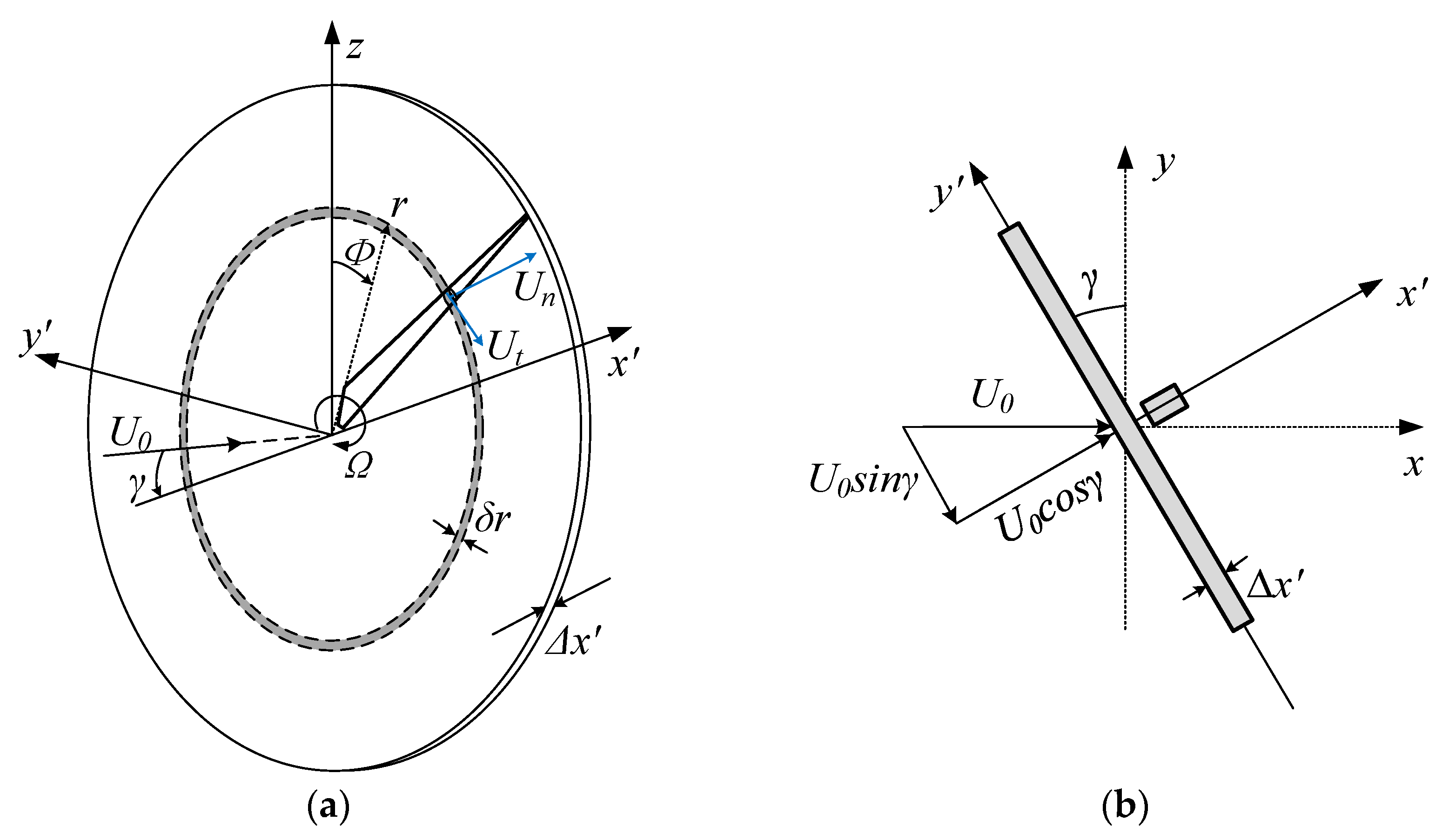
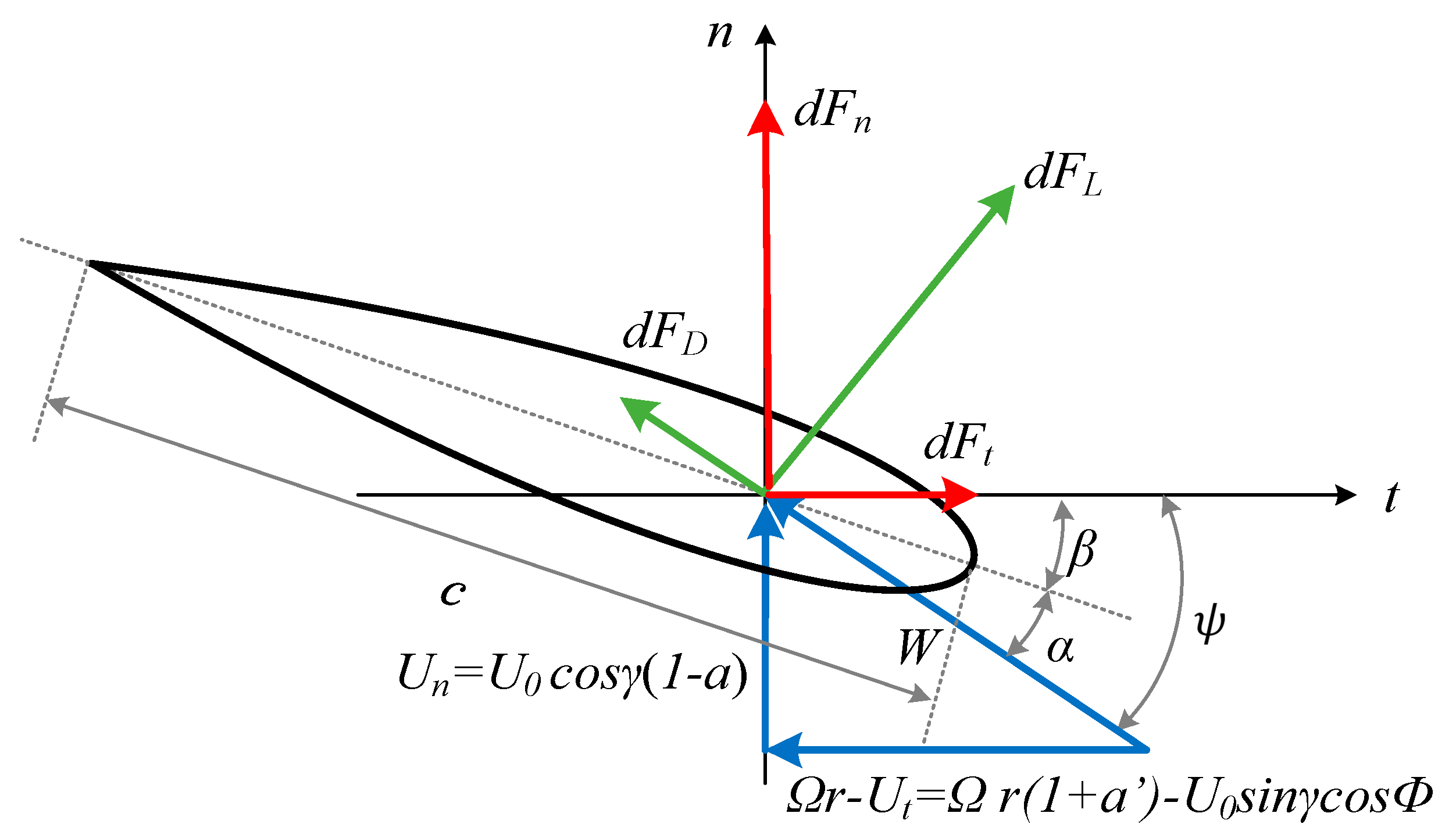
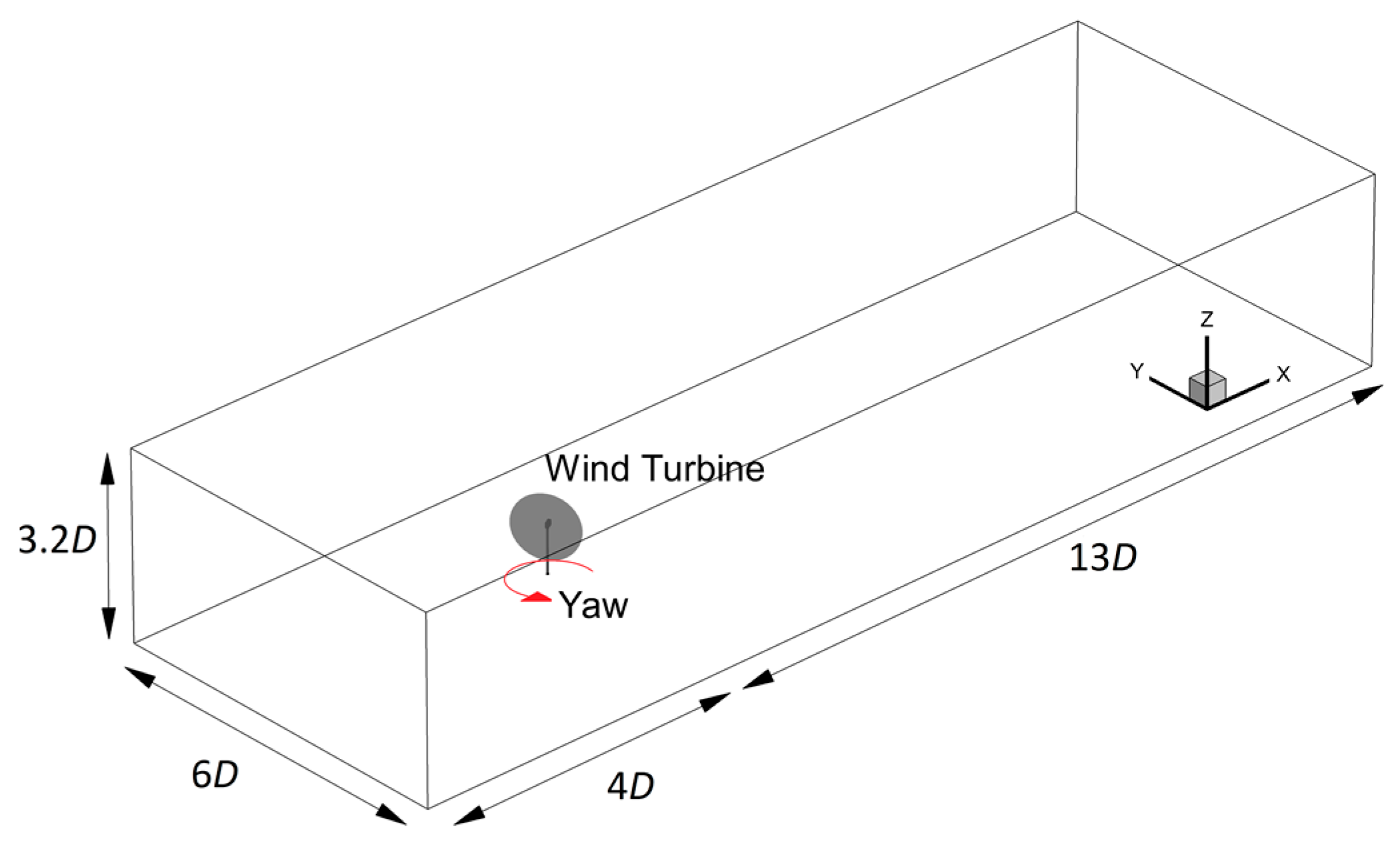

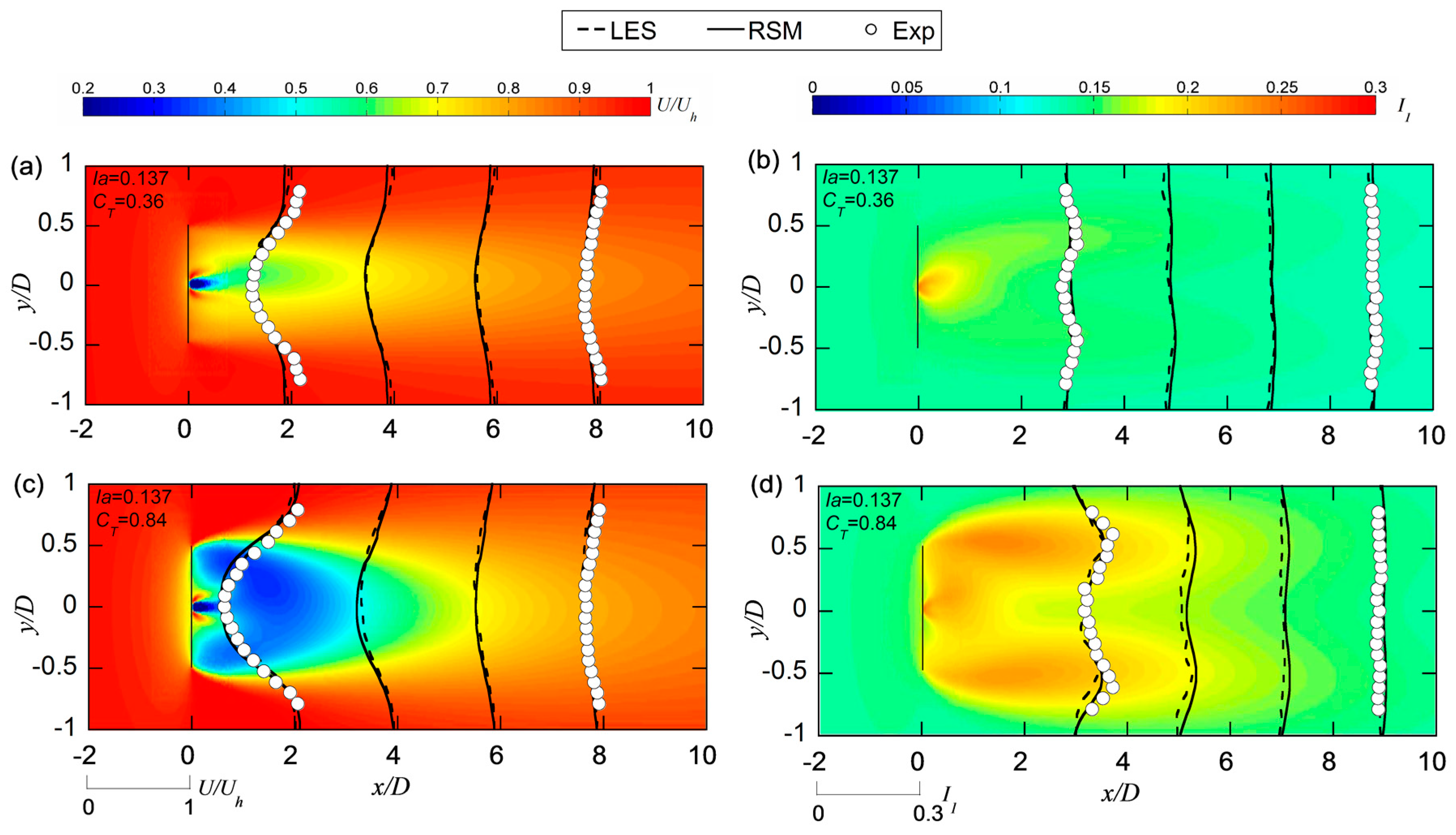
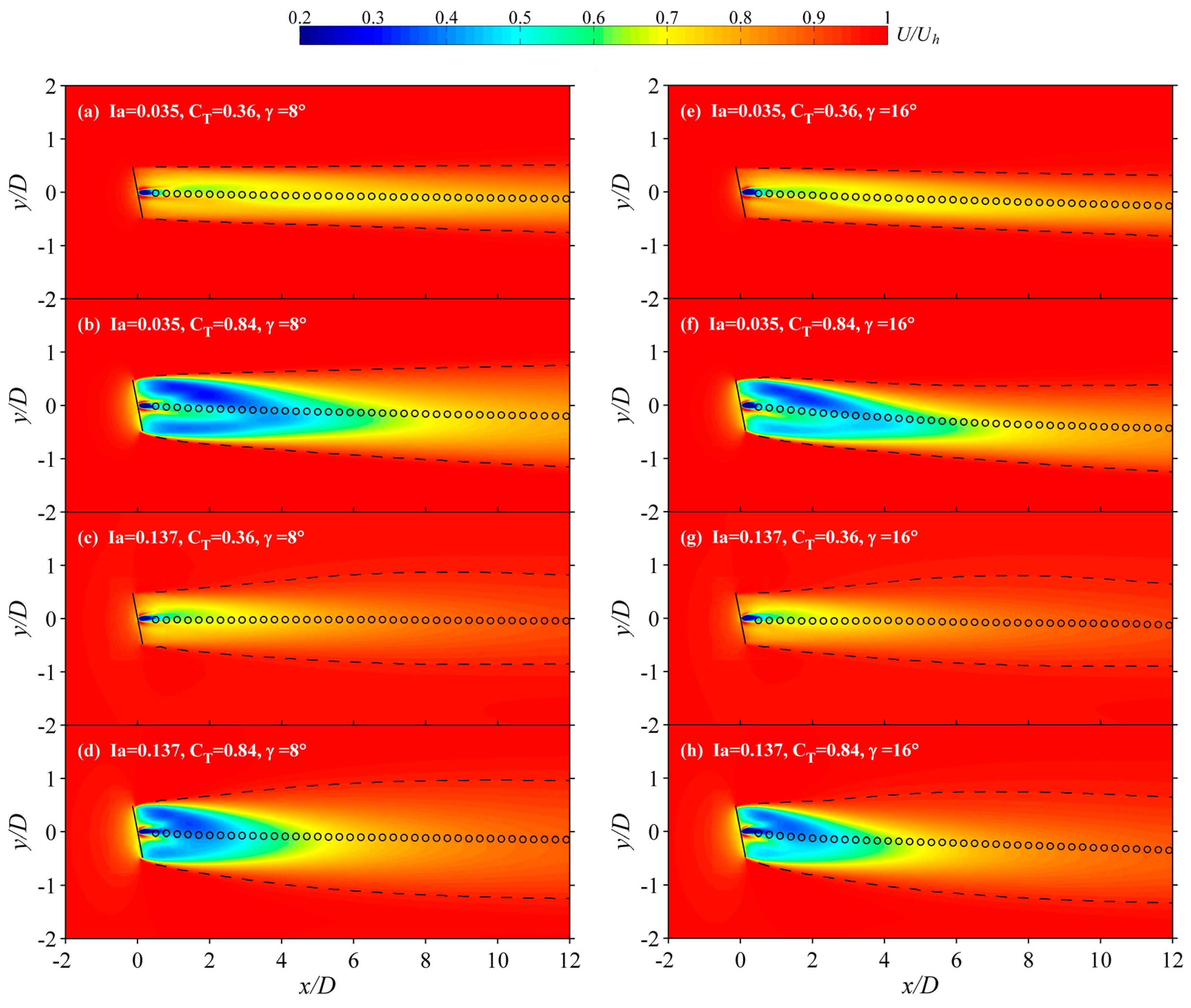


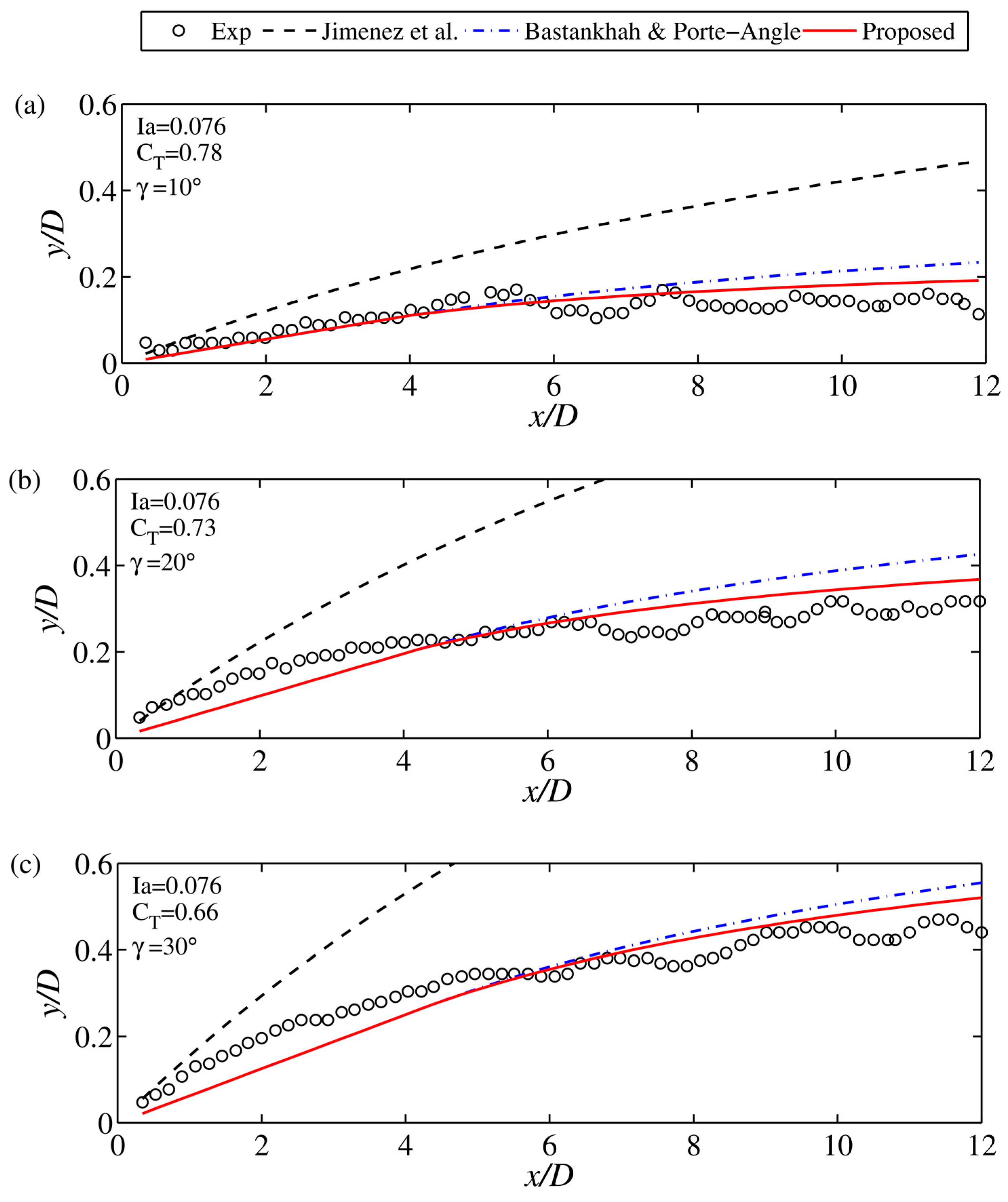
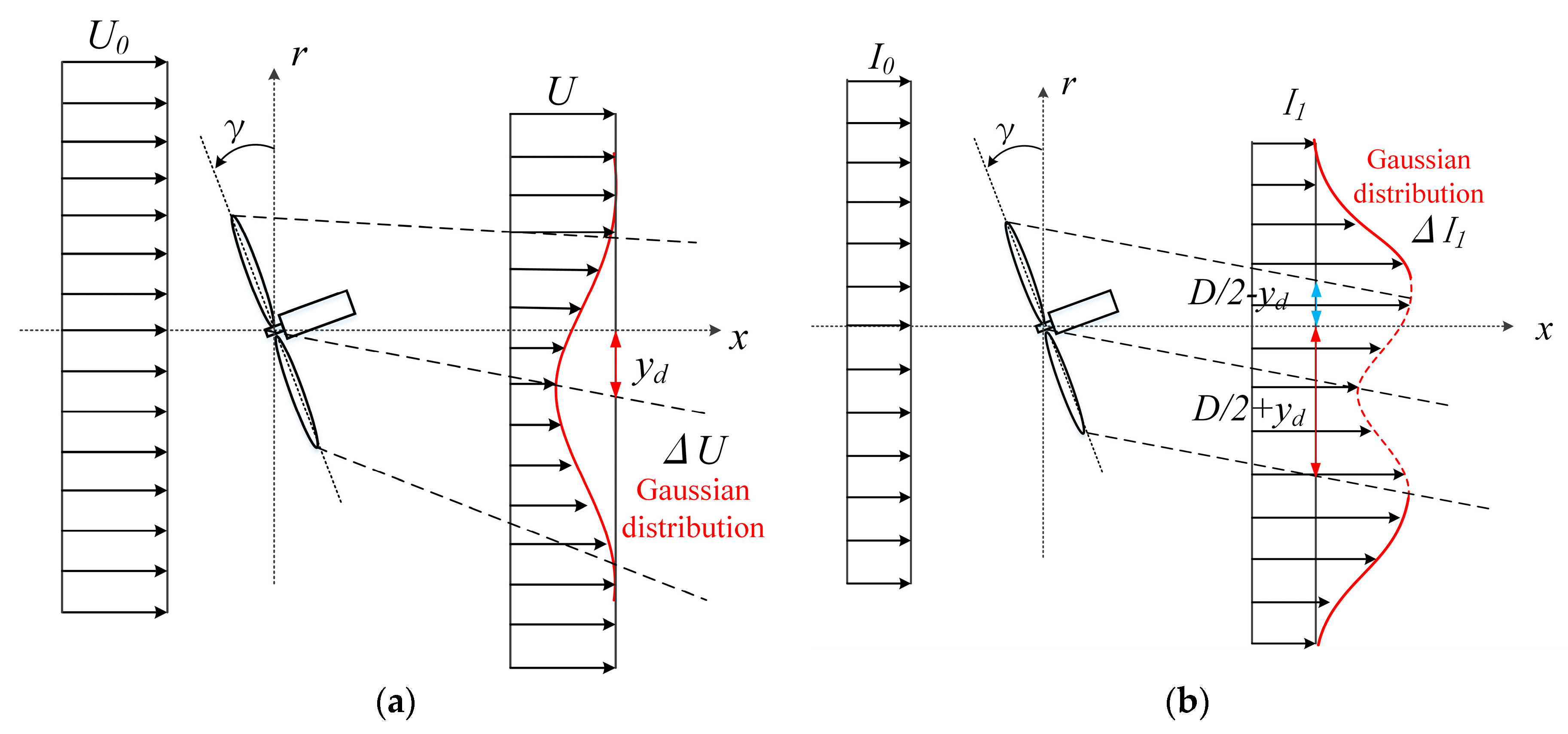
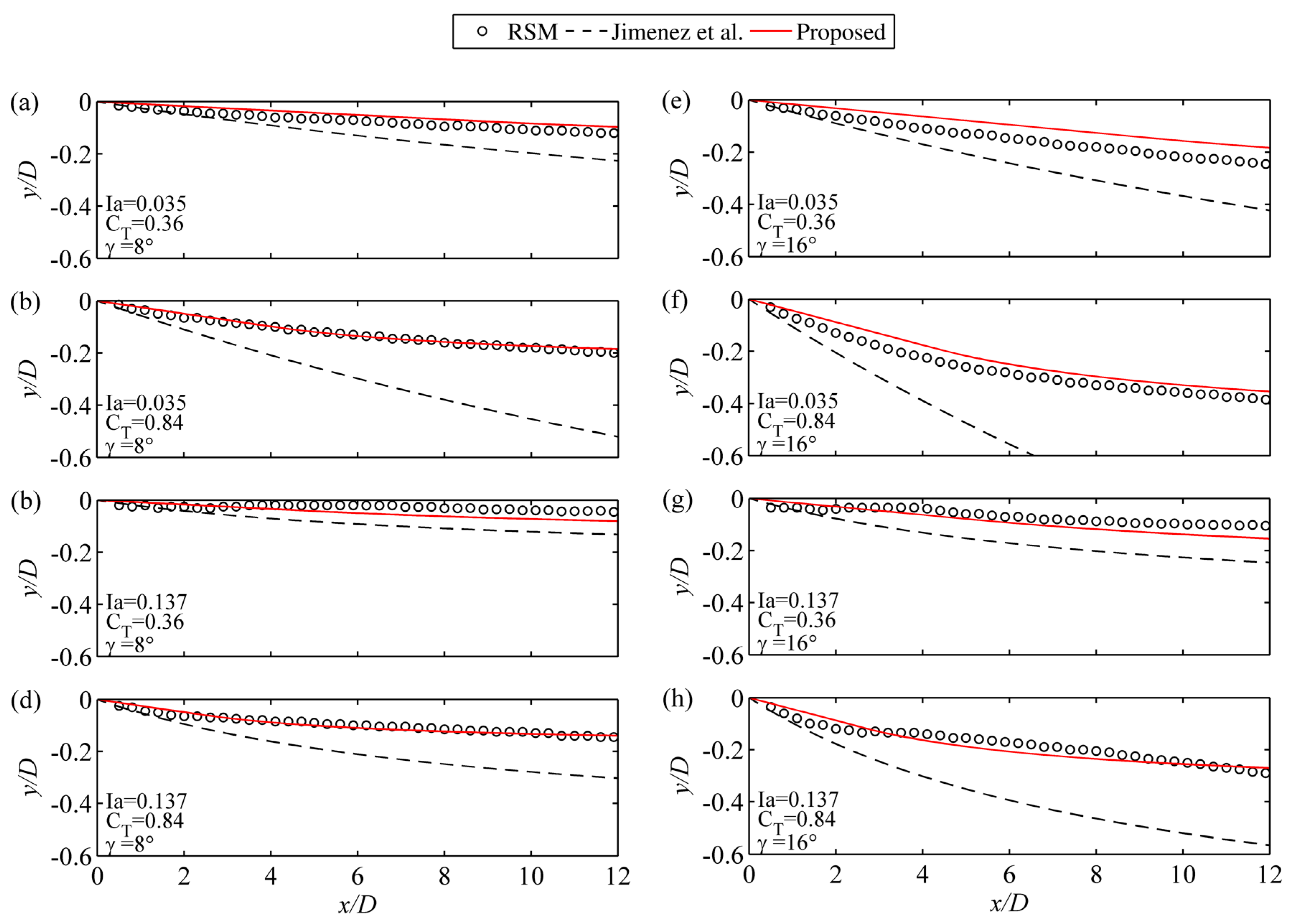
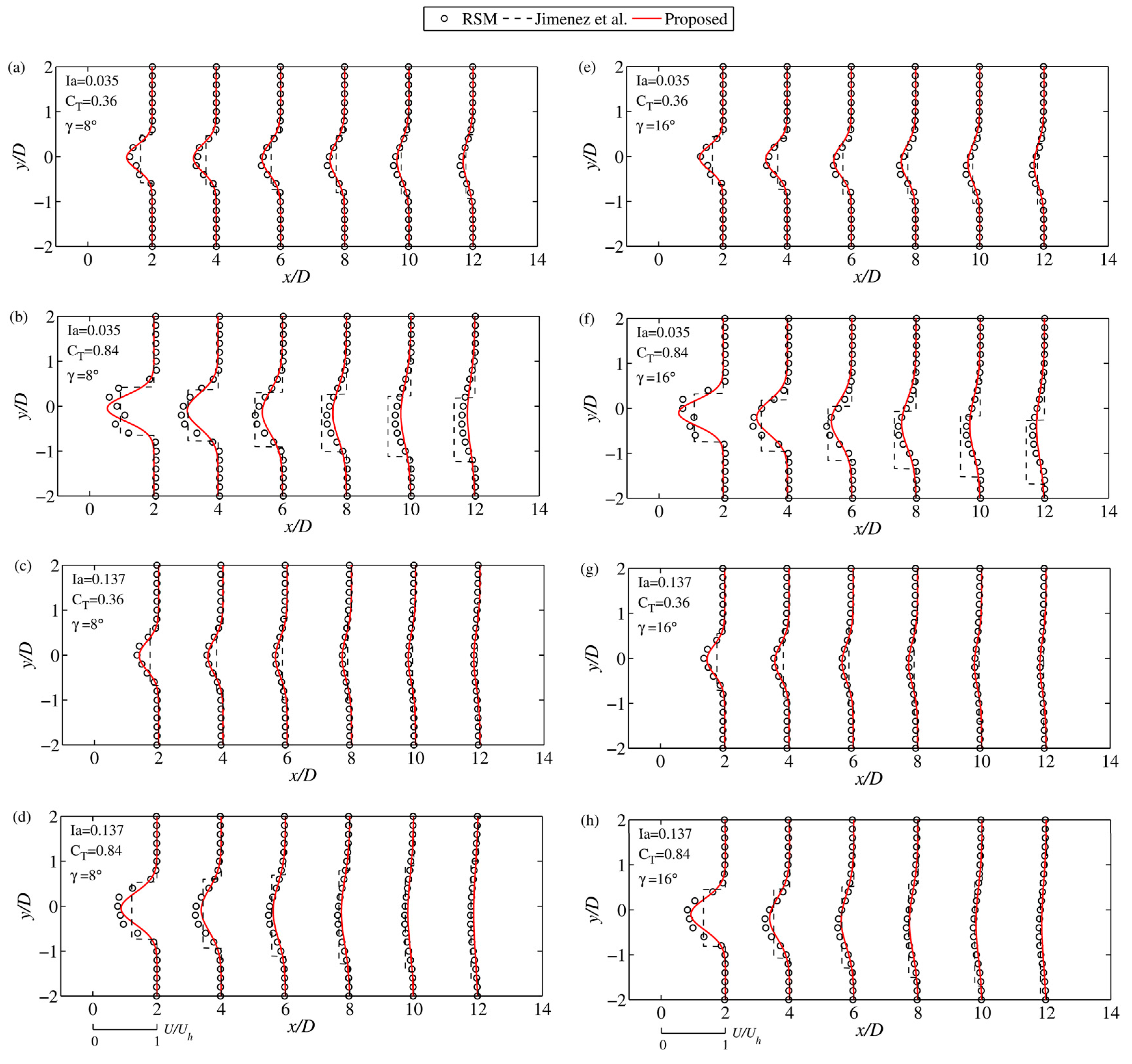
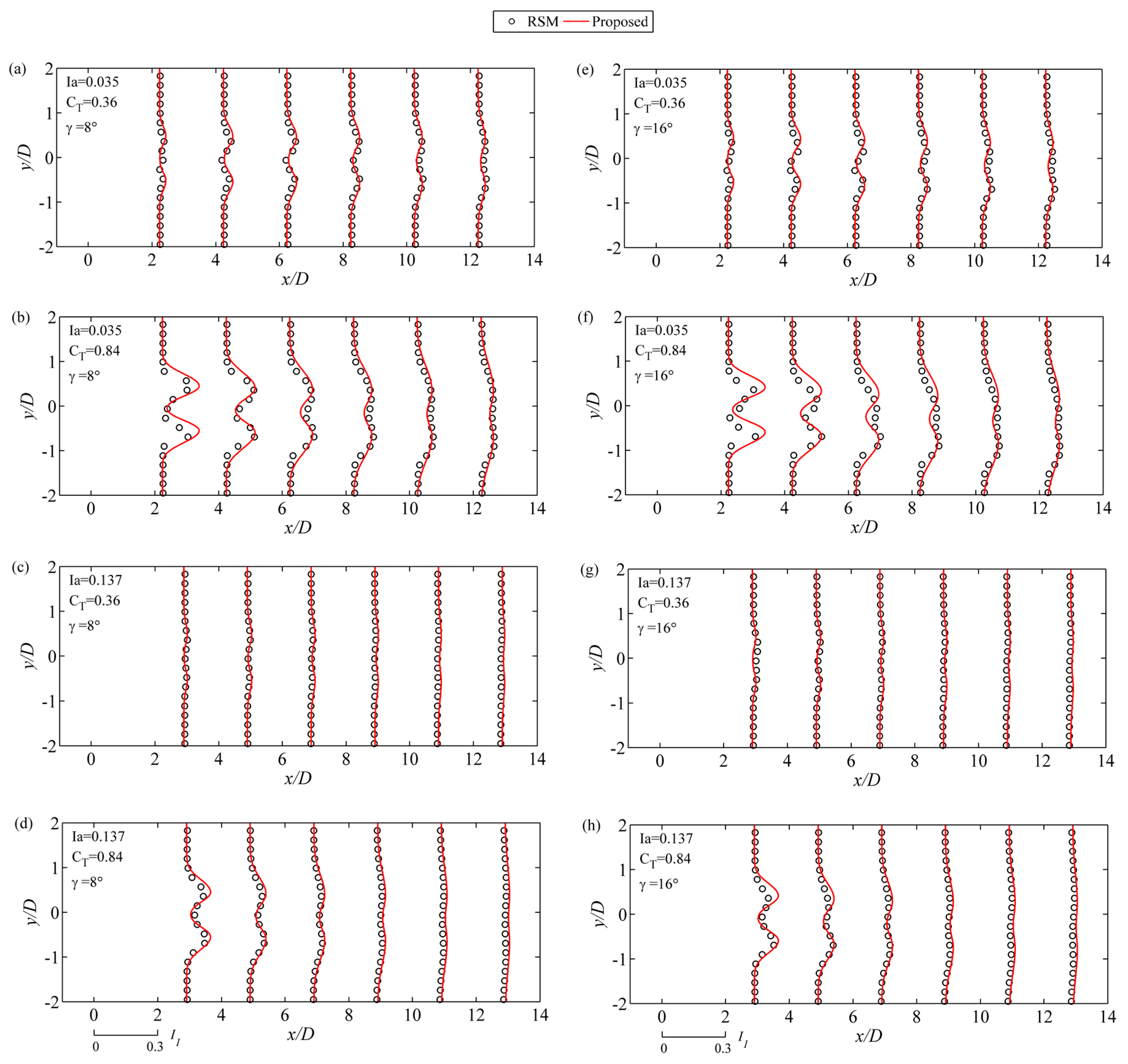
| Boundary | Specification |
|---|---|
| Inlet | Profiles of |
| Outlet | Outflow |
| Side | Symmetry |
| Top | Symmetry |
| Bottom | Logarithmic law |
| Case | (Deg.) | ||
|---|---|---|---|
| 1 | 8 | 0.035 | 0.36 |
| 2 | 8 | 0.035 | 0.84 |
| 3 | 8 | 0.137 | 0.36 |
| 4 | 8 | 0.137 | 0.84 |
| 5 | 16 | 0.035 | 0.36 |
| 6 | 16 | 0.035 | 0.84 |
| 7 | 16 | 0.137 | 0.36 |
| 8 | 16 | 0.137 | 0.84 |
| Inflow | |||||
| LES | 0.012 | 0.24 | 0.031 | 0.10 | |
| RSM | 0.015 | 0.26 | 0.032 | 0.13 | |
| Wake flow | , | , | |||
| LES | 0.068 | 0.078 | 0.071 | 0.12 | |
| RSM | 0.078 | 0.075 | 0.074 | 0.10 | |
| Model | |||
|---|---|---|---|
| Jiménez | 1.38 | 1.16 | 0.94 |
| Bastankhah and Porté-Agel | 0.31 | 0.23 | 0.13 |
| Proposed | 0.29 | 0.20 | 0.11 |
© 2018 by the authors. Licensee MDPI, Basel, Switzerland. This article is an open access article distributed under the terms and conditions of the Creative Commons Attribution (CC BY) license (http://creativecommons.org/licenses/by/4.0/).
Share and Cite
Qian, G.-W.; Ishihara, T. A New Analytical Wake Model for Yawed Wind Turbines. Energies 2018, 11, 665. https://doi.org/10.3390/en11030665
Qian G-W, Ishihara T. A New Analytical Wake Model for Yawed Wind Turbines. Energies. 2018; 11(3):665. https://doi.org/10.3390/en11030665
Chicago/Turabian StyleQian, Guo-Wei, and Takeshi Ishihara. 2018. "A New Analytical Wake Model for Yawed Wind Turbines" Energies 11, no. 3: 665. https://doi.org/10.3390/en11030665





